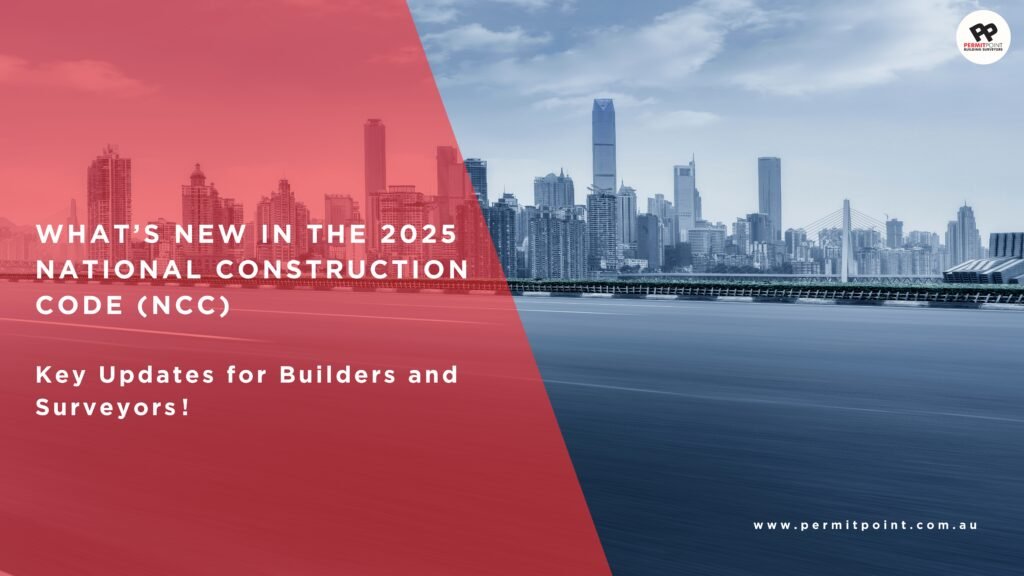The National Construction Code (NCC) is Australia’s primary set of technical design and construction provisions for buildings. Updated every three years, the NCC ensures that buildings are safe, sustainable, and meet the needs of the community. The 2025 edition introduces several significant changes aimed at enhancing building performance, safety, and sustainability. This blog outlines the key updates that builders and surveyors need to be aware of.
1. Enhanced Energy Efficiency Standards
The NCC 2025 continues Australia’s commitment to reducing greenhouse gas emissions by introducing stricter energy efficiency requirements:consultation.abcb.gov.au+2hia.com.au+2consultation.abcb.gov.au+2
- Commercial Buildings: New provisions focus on reducing peak heating and cooling loads, encouraging the use of renewable energy sources, and improving the overall energy performance of buildings. These changes aim to lower operational costs and environmental impact. consultation.abcb.gov.au
- Residential Buildings: The code introduces measures to improve the thermal performance of homes, including requirements for thermal breaks in steel-framed constructions and provisions for centralized heated water systems in apartments. consultation.abcb.gov.au
2. Provisions for Future Electrification and EV Charging
Recognizing the shift towards electrification and the growing adoption of electric vehicles (EVs), the NCC 2025 includes:
- Switchboard Capacity: Requirements to ensure that residential buildings have adequate switchboard capacity to accommodate future electrification needs.consultation.abcb.gov.au
- EV Charging Infrastructure: Provisions mandating the inclusion of infrastructure to support EV charging in new residential developments, facilitating easier installation of charging stations in the future. consultation.abcb.gov.au
3. Improved Condensation Management
To address health and structural issues associated with condensation, the NCC 2025 introduces:consultation.abcb.gov.au+2consultation.abcb.gov.au+2consultation.abcb.gov.au+2
- Vapour Permeance Requirements: Specifications for cavity-dependent vapour permeance in external walls to prevent moisture accumulation.consultation.abcb.gov.au
- Roof Ventilation: Expanded requirements for roof ventilation to mitigate condensation risks, particularly in cooler climates.
4. Enhanced Waterproofing and Water Shedding
Water ingress remains a significant issue in buildings. The NCC 2025 addresses this by:
- Improved Detailing: Clearer guidelines on waterproofing details to prevent water penetration.
- Material Specifications: Updated standards for materials used in wet areas to ensure durability and effectiveness in water shedding.
5. Fire Safety Enhancements
The NCC 2025 introduces several measures to bolster fire safety in buildings:
- Carpark Fire Safety: Improved requirements for fire safety in carparks, including better ventilation and fire suppression systems.
- Hybrid Photoluminescent Exit Signs: Mandating the use of exit signs that combine electric illumination with photoluminescent technology to ensure visibility during power outages.
- Re-entry from Fire-Isolated Exits: Provisions to allow safe re-entry from fire-isolated exits, enhancing occupant safety during emergencies. consultation.abcb.gov.au
6. Structural Performance Solutions
To ensure the structural integrity of buildings, the NCC 2025 includes:consultation.abcb.gov.au+1consultation.abcb.gov.au+1
- Performance-Based Solutions: Guidance on developing and assessing performance-based structural solutions, providing flexibility while maintaining safety standards.
- Use of Accredited Testing Laboratories: Requirements for materials and systems to be tested by accredited laboratories, ensuring reliability and compliance.
7. Plumbing Provisions Updates
The NCC 2025 updates plumbing provisions to enhance health and environmental outcomes:
- Water Heater Requirements: Specifications for installing and performing water heaters to ensure energy efficiency and safety.
- Rainwater Systems: Guidelines for designing and maintaining rainwater harvesting systems, promoting sustainable water use.
8. Gender Equity in Sanitary Facilities
Addressing gender equity, the NCC 2025 introduces:
- Adequate Toilets for Women: Requirements to ensure a sufficient number of sanitary facilities for women in public buildings, reducing wait times and improving accessibility. consultation.abcb.gov.au
9. Referenced Documents and Standards
The NCC 2025 updates several referenced documents and standards to align with current best practices:
- Fire Hazard Properties: Updated standards for assessing the fire hazard properties of materials used in construction.consultation.abcb.gov.au
- Alternative Referenced Documents: Inclusion of alternative documents that provide equivalent or superior performance criteria, offering flexibility in compliance.
Conclusion
The NCC 2025 brings comprehensive updates that reflect the evolving needs of the building industry, focusing on sustainability, safety, and occupant well-being. Builders and surveyors must familiarize themselves with these changes to ensure compliance and deliver high-quality, future-ready buildings.
For detailed information and to access the full NCC 2025 Public Comment Draft, visit the Australian Building Codes Board (ABCB) Consultation Hub.consultation.abcb.gov.au+6consultation.abcb.gov.au+6consultation.abcb.gov.au+6




